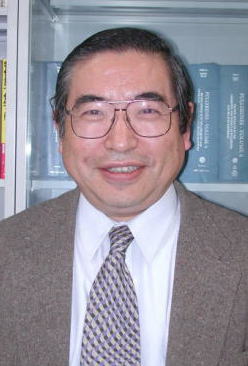
Prof. Shunichi Fukuzumi
Department of Material and Life Science,
Graduate School of Engineering, Osaka University

(Upload 13.4.2005)
The Chemical Society of Japan

|
Shunichi Fukuzumi, professor of Osaka University, has been selected to receive the Chemical Society of Japan (CSJ) Award in 2005. He is one of six selected to receive the award, which is given in recognition of a significant contribution to the fundamentals and applications of chemistry. Electron transfer is one of the most fundamental chemical reactions, playing a pivotal role not only in chemical processes but also in biological redox processes, which are essential for life, such as photosynthesis and respiration, since electron is the minimal unit of the change in chemical reactions. Fukuzumi's research has been designed to facilitate the development of efficient electron-transfer systems as nature has developed to a high degree of perfection in biological systems such as photosynthesis and respiration. Most biological electron transfer reactions are mediated by redox coenzymes such as NAD(P)H (NAD+ = nicotinamide adenine dinucleotide; NADP+ = nicotinamide adenine dinucleotide phosphate; NADH, NADPH = the reduced forms of NAD+ and NADP+, respectively) and flavins. The NAD(P)H coenzymes act as a source of two electrons and a proton, thus formally transferring a hydride ion to a substrate. Fukuzumi has clarified the stepwise mechanism of transfers of electrons and proton of coenzyme analogs by detecting the intermediate radical species for the first time. He has also shown that a variety of biological, organic and organometallic reactions, previously formulated by "movements of electron pairs" are now understood as processes in which an initial electron transfer from a nucleophile (reductant) to an electrophile (oxidant) produces a radical ion pair, which leads to the final products via the follow-up steps involving cleavage and formation of chemical bonds. The follow-up steps are usually sufficiently rapid to render the initial electron transfer the rate-determining step in an overall irreversible chemical transformation. Fukuzumi has demonstrated that inner-sphere electron transfer reactions with strong interaction between donor and acceptor molecules proceed via formation of charge transfer complexes by finding the negative temperature effects provided that the activation energy of electron transfer in the charge-transfer complexes is smaller than the charge-transfer stabilization energy. He has also unified the Marcus theory of electron transfer with the Mulliken charge-transfer theory, allowing outer-sphere and inner-sphere electron transfer reactions to evolve a single view point. Extensive efforts have been devoted to design molecular systems capable of effecting photoinduced charge separation under illumination with visible light for the solar energy conversion. Fukuzumi has successfully developed multi-step electron-transfer systems which can well mimic functions of the photosynthetic reaction center for the first time. Although this is a tremendous achievement, the synthesis of such an artificial photosynthetic reaction center is extremely time consuming, and significant amount of energy is lost during the multi-step electron transfer processes. Then, he has further developed a new rational design to attain a long-lived and high energy charge-separated state without significant loss of excitation energy by fine control of the redox potentials and geometry of simple donor-acceptor dyads which have small reorganization energies of electron transfer. He has shown that the rational design of simple molecular dyads capable of fast charge separation but extremely slow charge recombination has significant advantages with regard to synthetic feasibility, providing a variety of applications including construction of organic solar cells and development of efficient photocatalytic systems for the solar energy conversion. Among the goals of Fukuzumi's research are also to control electron transfer processes by non-covalent bonding of radical anions (the products of electron transfer) with metal ions which can act as Lewis acids to accelerate or decelerate electron-transfer reactions. He has established quantitative measures to determine the Lewis acidity of a variety of metal ions in relation with the promoting effects of metal ions on the electron-transfer reactions. He has demonstrated the mechanistic viability of metal ion catalysis in electron transfer reactions by finding a variety of examples of chemical transformations involving metal ion-promoted electron transfer processes as the rate-determining steps, which are made possible to proceed by complexation of radical anions with metal ions. Such metal ion-promoted electron transfer processes have been shown to play a pivotal role in the development of respiration and superoxide dismutase (SOD) model systems, providing a wide and versatile scope of electron transfer chemistry. In particular, an efficient four-electron reduction of dioxygen to water by one-electron reductants such as ferrocene derivatives as well as by an NADH analog has been achieved by using a cofacial dicobalt porphyrin that can form the µ-peroxo Co(III)-O2-Co(III) complex. The catalytic mechanism of the four-electron reduction of dioxygen has been clarified based on the detailed kinetic study. In summary, Fukuzumi has made notable and significant contributions to provide new paradigm of electron transfer chemistry which has tremendous potentials for valuable applications. He earned a bachelor's degree and PhD. degree in applied chemistry at Tokyo Institute of Technology in 1973 and 1978, respectively. After working as a postdoctoral fellow (1978-1981) at Indiana University in USA, he joined the Department of Applied Chemistry, Osaka University, as an Assistant Professor in 1981 and was promoted to a Full Professor in 1994. His research interests are electron transfer chemistry in the areas of all fields of chemistry. He has published nearly 450 original papers and 50 review articles and books. He has been the director of a CREST (Core Research for Evolutional Science and Technology) project of Japan Science and Technology Agency since 1999, which is now extended as a SORST (Solution Oriented Research for Science and Technology) project after highly competitive selection. |